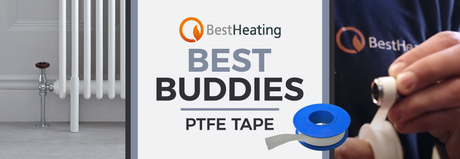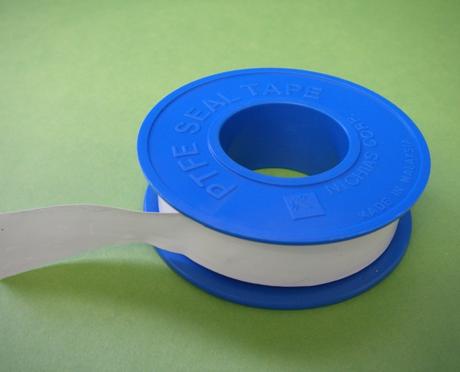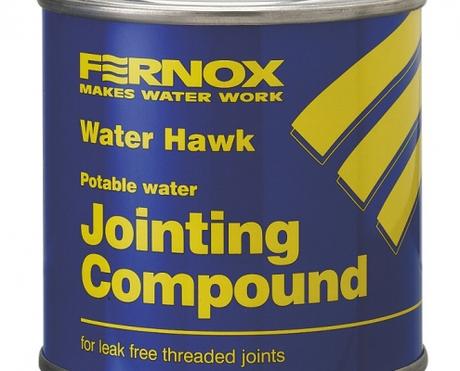
BestHeating Best Buddies – PTFE Tape
The BestHeating Best Buddies blog series shines a spotlight on some of the more innocuous objects and items that can turn out to be real heroes of the home heating universe.
First under the microscope is PTFE tape – considered an essential for plumbers, and your go-to grip for the installation of radiators and heated towel rails.
Read on to find out everything you need to know about the tape, and to learn why professionals in the heating industry swear by it.
What is PTFE Tape?
To give it it’s full, ‘Sunday’ name, it is actually referred to as Polytetrafluoroethylene Tape. Not hard to see why the abbreviation is so commonly used, is it?
There are a number of alternative monikers as well, including Thread Seal Tape, Teflon Tape, and Plumber’s Tape, such is the popularity of the stuff amongst those who literally make a living in the world of heating solutions.
Essentially, it is a type of tape primarily used in the wrapping of pipe threads or at a jointing compound, and helps to prevent leaks occurring at the joints on devices, for instance on radiator taps or valves.

How to use PTFE Tape?
For any plumbers who might have stumbled across this blog, these instructions will be akin to telling Lionel Messi what to do with a football at his feet, Tiger Woods how to hold a golf club, or Ric Flair how to exercise his vocal chords.
But for us mere mortals amongst us whose livelihoods don’t depend on being well versed in heating tech and terminology (myself excluded), here’s the best practice to follow for the application of PTFE tape.
The right way to apply it is to follow the direction of the thread, in the same way you would when tightening the nut. In almost any scenario, nuts will tighten in a clockwise direction, so you should mirror that approach when applying the tape.
If you did want to test the theory for whatever reason, you could try wrapping the tape in an anti-clockwise direction around the thread.
This will probably prove especially awkward for right-handers, but the main sticking point will come when you attempt to screw the nut on. At this point, you’ll find that the tape will begin to drop off the thread, rendering it much like Mesut Ozil in a crunch away clash – totally useless.
Alas, your faith in wrapping PTFE tape in a clockwise direction is restored.
The recommendation when applying the tape clockwise, is to wrap it around the thread joints three or four times. This will be enough to provide adequate protection for the prevention of leaks, but not so thick that it makes it impossible to attach the nut.
You’ll find, when applying the nut on top of clockwise-wound tape, that is will fit snugly and the tape will hold its position – a direct opposite result of what occurs when PTFE tape is wound anti-clockwise.
Dream Team – PTFE Tape and Jointing Compound
Been spendin’ most their lives, living in a plumber’s paradise.
PTFE Tape and jointing compound are sure to feature in the video should Coolio ever decide to stick a unique twist on his remastered classic, however unlikely that may be.
Even so, jointing compound is a highly recommended accompaniment for the installation of a new radiator or valve – basically any central heating component attachment.
Indeed, the use of plumber’s tape alongside a silicone-based jointing compound should result in a watertight joint fitting. The way to do it is to apply a moderate portion of jointing compound around the thread once the tape has been applied, and use your finger to smooth it over.
Only a small amount of compound is needed and you can get rid of any excess before attaching the nut. Essentially, the teaming of PTFE tape with the jointing compound serves to properly ensure the joints are leak-proof.
The vast majority of plumbers or heating professionals will endorse the use of PTFE tape and jointing compound for any new heating installations. This is the case as it’s far easier to do the job properly initially, as opposed to draining all the components down again just to apply it.
Save yourself plenty of hassle, and just allow this match made in heaven to combine from the off in your heating system fittings.

You probably didn’t know that…
Whilst PTFE tape is most often used by plumbers and alongside heating solutions, there is an alternative use.
This rather unusual purpose is for piercings. Plumber’s tape has inert properties, meaning it won’t cause any reaction in the human body. As such, some people opt to use it for the stretching of piercings, whether they be situated in the ear, nose or any other (perhaps unmentionable) area. By wrapping the tape around the plug, it will make the hole bigger.

Get in touch with BestHeating
Your local DIY shop is sure to stock PTFE tape, but if you do have any further questions regarding it, or have any other heating queries, please don’t hesitate to get in touch with us.
You can leave your thoughts in the comments section below, or contact us via Instagram, Facebook or Twitter.


